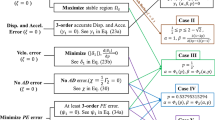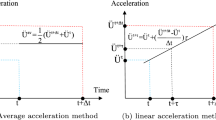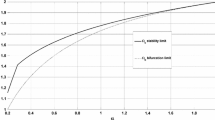Abstract
An improved time-marching procedure based on a composite explicit method is proposed for non-viscous damping systems. In this method, an improved integral approximation scheme is developed to improve the convolution solution accuracy and is applicable to any causal kernel function. The mathematical derivation and calculation procedure based on the composite explicit method are formulated for non-viscous damping systems. The adopted composite explicit method shows more desirable stability and accuracy properties than other competitive explicit methods. Numerical simulations of some representative examples demonstrate the proposed time-marching procedure is efficient for the dynamic analysis of non-viscous damping systems.









































Similar content being viewed by others
Data availability
The data that has been used is confidential.
References
Woodhouse J (1998) Linear damping models for structural vibration. J Sound Vib 215(3):547–569
Rayleigh L, Nachtrieb NH (1957) The theory of sound
Pan Y, Wang Y (2013) Frequency-domain analysis of exponentially damped linear systems. J Sound Vib 332(7):1754–1765
Ding Z, Li L, Hu Y (2018) A modified precise integration method for transient dynamic analysis in structural systems with multiple damping models. Mech Syst Signal Process 98:613–633
Palmeri A, Muscolino G (2011) A numerical method for the time-domain dynamic analysis of buildings equipped with viscoelastic dampers. Struct Control Health Monit 18(5):519–539
Mastroddi F, Martarelli F, Eugeni M et al (2019) Time- and frequency-domain linear viscoelastic modeling of highly damped aerospace structures. Mech Syst Signal Process 122:42–55
Park SO, Choi WH, Park GJ (2020) Dynamic response optimization of structures with viscoelastic material using the equivalent static loads method. Proc Inst Mech Eng Part D J Automob Eng 235(2–3):589–603
Zghal S, Bouazizi ML, Bouhaddi N et al (2015) Model reduction methods for viscoelastic sandwich structures in frequency and time domains. Finite Elem Anal Des 93:12–29
Mouritz AP, Gellert E, Burchill P et al (2001) Review of advanced composite structures for naval ships and submarines. Compos Struct 53(1):21–42
Zhou XQ, Yu DY, Shao XY et al (2016) Research and applications of viscoelastic vibration damping materials: a review. Compos Struct 136:460–480
Adhikari S, Wagner N (2004) Direct time-domain integration method for exponentially damped linear systems. Comput Struct 82(29):2453–2461
Adhikari S, Wagner N (2003) Analysis of asymmetric nonviscously damped linear dynamic systems. J Appl Mech 70(6):885–893
Biot MA (1955) Variational principles in irreversible thermodynamics with application to viscoelasticity. Phys Rev 97(6):1463–1469
Golla DF, Hughes PC (1985) Dynamics of viscoelastic structures—a time-domain, finite element formulation. J Appl Mech 52(4):897–906
Lesieutre GA, Mingori DL (1990) Finite element modeling of frequency-dependent material damping using augmenting thermodynamic fields. Aiaa J Guid Control Dyn 13(6):1040–1050
Reggio A, De Angelis M, Betti R (2013) A state-space methodology to identify modal and physical parameters of non-viscously damped systems. Mech Syst Signal Process 41(1):380–395
Li L, Hu Y, Wang X (2014) Harmonic response calculation of viscoelastic structures using classical normal modes: an iterative method. Comput Struct 133:39–50
Liu Q (2018) Stationary random response of non-viscously damped polymer matrix composite structure systems. Compos Struct 202:1–8
Cortés F, Mateos M, Elejabarrieta MJ (2009) A direct integration formulation for exponentially damped structural systems. Comput Struct 87(5):391–394
Dokainish MA, Subbaraj K (1989) A survey of direct time-integration methods in computational structural dynamics—I. Explicit methods. Comput Struct 32(6):1371–1386
Subbaraj K, Dokainish MA (1989) A survey of direct time-integration methods in computational structural dynamics—II. Implicit methods. Comput Struct 32(6):1387–1401
Bathe KJ, Baig MMI (2005) On a composite implicit time integration procedure for nonlinear dynamics. Comput Struct 83(31):2513–2524
Bathe KJ (1996) Finite element procedures. Prentice Hall, Upper Saddle River
Liu Q (2014) Computational method of the dynamic response for nonviscously damped structure systems. J Eng Mech 140(11):04014085
Puthanpurayil AM, Carr AJ, Dhakal RP (2014) A generic time domain implementation scheme for non-classical convolution damping models. Eng Struct 71:88–98
Shen R, Qian X, Zhou J (2019) Direct integration for non-viscous structural systems and its simplification. Mech Res Commun 95:8–15
Liu Q (2016) Explicit computational method of dynamic response for non-viscously damped structure systems. Mech Res Commun 71:48–55
Zhai W (1996) Two simple fast integration methods for large-scale dynamic problems in engineering. Int J Numer Methods Eng 39(24):4199–4214
Hulbert GM, Chung J (1996) Explicit time integration algorithms for structural dynamics with optimal numerical dissipation. Comput Methods Appl Mech Eng 137(2):175–188
Tchamwa B, Conway T, Wielgosz C (1999) An accurate explicit direct time integration method for computational structural dynamics. ASME Int Mech Eng Congr Expos 16448:77–84
Soares D (2022) Three novel truly-explicit time-marching procedures considering adaptive dissipation control. Eng Comput 38(4):3251–3268
Wen W, Deng S, Duan S et al (2021) A high-order accurate explicit time integration method based on cubic b-spline interpolation and weighted residual technique for structural dynamics. Int J Numer Methods Eng 122(2):431–454
Noh G, Bathe KJ (2013) An explicit time integration scheme for the analysis of wave propagations. Comput Struct 129:178–193
Wen W, Liu T, Duan S (2022) A novel sub-step explicit time integration method based on cubic B-spline interpolation for linear and nonlinear dynamics. Comput Math Appl 127:154–180
Shen R, Qian X, Zhou J et al (2021) A time integration method based on the weak form Galerkin method for non-viscous damping systems. Mech Syst Signal Process 151:107361
Wagner N, Adhikari S (2003) Symmetric state-space method for a class of nonviscously damped systems. AIAA J 41(5):951–956
Acknowledgements
This research is substantially supported by the National Natural Science Foundation of China (Nos. 12072375, 12102043), the Natural Science Foundation of Hunan Province, China (No. 2021JJ40710) and the Fundamental Research Funds for the Central Universities of Central South University (No. 2022ZZTS0615).
Author information
Authors and Affiliations
Corresponding author
Ethics declarations
Conflict of interest
The authors declare that there are no conflicts of interest.
Additional information
Publisher's Note
Springer Nature remains neutral with regard to jurisdictional claims in published maps and institutional affiliations.
Appendices
Appendix A: The Noh-Bathe method for non-viscous damping systems
Here the calculation procedure of the Noh-Bathe method for non-viscous systems is provided. The Noh-Bathe method is a classical explicit time integration method that divides each time step \(\Delta t\) into two sub-steps. The time step sizes are \(p\Delta t\) for the first sub-step and \(\left(1-p\right)\Delta t\) for the second sub-step, where \(0<p<1\). The improved integral approximation scheme to deal with the convolution of damping force is adopted here.
The governing equation for non-viscous damping systems at time \(t+p\Delta t\) and \(t+\Delta t\) can be found in Eqs. (4) and (21), respectively. The initial displacement and velocity can be obtained by Eq. (3). For the first sub-step, the non-viscous damping force is written as
where
The velocity function vector \(\dot{{\varvec{x}}}\left(\tau \right)\) of \({{\varvec{F}}}_{\mathrm{damp}1}^{^{\prime}}\) and \({{\varvec{F}}}_{\mathrm{damp}2}^{^{\prime}}\) can be, respectively, expressed as
Substituting (65) and (66) into (63) and (64) respectively, the damping force for the first sub-step is rewritten as
For nonintegrable functions, the damping force can be formulated as follow
The acceleration vector for the first sub-step is obtained as
The displacement vector for the first sub-step can be calculated by
The velocity vector for the first sub-step is adopted as
For the second sub-step, the non-viscous damping force can be written as
where
The velocity vector functions \(\dot{{\varvec{x}}}\left(\tau \right)\) can be, respectively, substituted as the Eqs. (65) and (66). Then, the \({{\varvec{F}}}_{\mathrm{damp}1}\) and \({{\varvec{F}}}_{\mathrm{damp}2}\) can be rewritten as
If closed-form solutions of the above integrals cannot be obtained directly, the damping force for the second sub-step can be formulated as follow
The final acceleration vector for the second sub-step is solved by
The final displacement vector for the second sub-step is formulated as
The final velocity vector for the second sub-step is calculated by
Appendix B: The theoretical solution of the system in numerical example 1
The dynamic kernel governing equation of the SDOF system under sinusoidal load is express as
with initial conditions \(x\left(0\right)={x}_{0}\), \(\dot{x}\left(0\right)={v}_{0}\), and the initial acceleration value can be calculated as \(\ddot{x}\left(0\right)=-\frac{kx\left(0\right)}{m}\).
After Laplace transformation, Eq. (84) can be rewritten as
where \(s\) is the Laplace domain parameter.
The Eq. (87) can be rewritten as
The characteristic equation is expressed as
Let \(a\),\(b\),\(c\),\(d\) represent coefficients of the cubic term, the quadratic term, the first-order term and the zeroth-order term of the above equation, respectively. That is, \(a=1\),\(b=\mu\),\(c=\frac{c\mu }{m}+\frac{k}{m}\),\(d=\frac{k\mu }{m}\).
The roots of Eq. (88) are given as
where \(u=\sqrt[3]{{\eta }^{2}+\sqrt{{\eta }^{2}+{\zeta }^{3}}}\), \(\nu =\sqrt[3]{{\eta }^{2}-\sqrt{{\eta }^{2}+{\zeta }^{3}}}\), \(\eta =\frac{9abc-27{a}^{2}d-2{b}^{3}}{54{a}^{3}}\), \(\zeta =\frac{3ac-{b}^{2}}{9{a}^{2}}\). And let \(\alpha\) and \(\beta\) be the real and imaginary parts of \({s}_{3}\), respectively. That is, \(\alpha =-\frac{b}{3a}-\frac{1}{2}\left(u+\nu \right)\), \(\beta =\frac{\sqrt{3}}{2}\left(u-\nu \right)\).
Then, the general solution of a homogeneous equation in the time domain can be adopted as
where
Adopting inverse Laplace transform, Eq. (86) can transform into the time domain as
The special solution form of the nonhomogeneous differential Eq. (93) can be assumed to be
Substituting Eq. (94) into Eq. (93), the values of \(A\) and \(B\) can be obtained as
where \(e=\frac{k\mu }{m}-\mu {\theta }^{2}\), \(f={\theta }^{3}-\frac{\theta \left(c\mu +k\right)}{m}\).
The general solution of Eq. (84) can be written as
Rights and permissions
Springer Nature or its licensor (e.g. a society or other partner) holds exclusive rights to this article under a publishing agreement with the author(s) or other rightsholder(s); author self-archiving of the accepted manuscript version of this article is solely governed by the terms of such publishing agreement and applicable law.
About this article
Cite this article
Liu, T., Wen, W., Wang, P. et al. A time-marching procedure based on a sub-step explicit time integration scheme for non-viscous damping systems. Engineering with Computers 40, 1005–1025 (2024). https://doi.org/10.1007/s00366-023-01838-3
Received:
Accepted:
Published:
Issue Date:
DOI: https://doi.org/10.1007/s00366-023-01838-3




